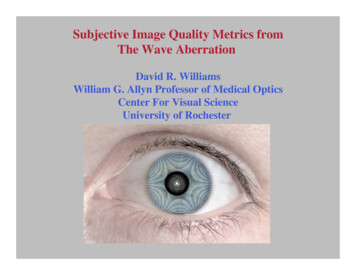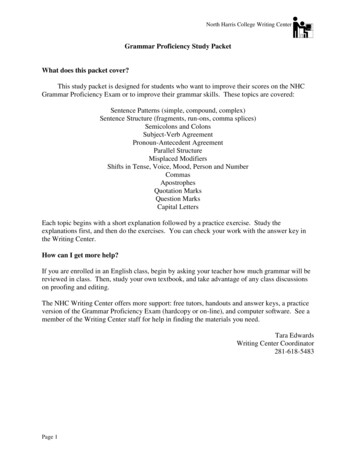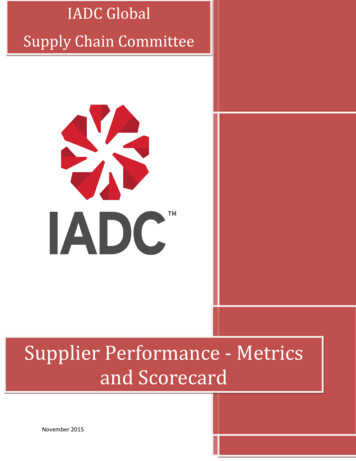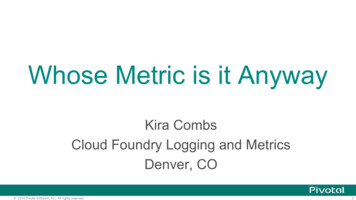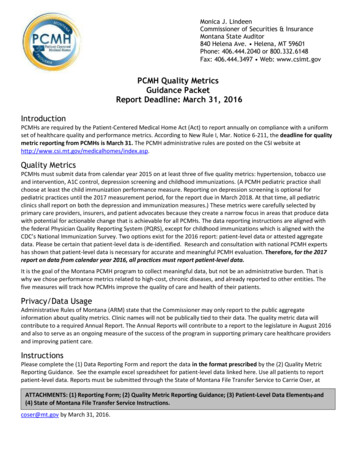
Transcription
Monica J. LindeenCommissioner of Securities & InsuranceMontana State Auditor840 Helena Ave. Helena, MT 59601Phone: 406.444.2040 or 800.332.6148Fax: 406.444.3497 Web: www.csimt.govPCMH Quality MetricsGuidance PacketReport Deadline: March 31, 2016IntroductionPCMHs are required by the Patient-Centered Medical Home Act (Act) to report annually on compliance with a uniformset of healthcare quality and performance metrics. According to New Rule I, Mar. Notice 6-211, the deadline for qualitymetric reporting from PCMHs is March 31. The PCMH administrative rules are posted on the CSI website lity MetricsPCMHs must submit data from calendar year 2015 on at least three of five quality metrics: hypertension, tobacco useand intervention, A1C control, depression screening and childhood immunizations. (A PCMH pediatric practice shallchoose at least the child immunization performance measure. Reporting on depression screening is optional forpediatric practices until the 2017 measurement period, for the report due in March 2018. At that time, all pediatricclinics shall report on both the depression and immunization measures.) These metrics were carefully selected byprimary care providers, insurers, and patient advocates because they create a narrow focus in areas that produce datawith potential for actionable change that is achievable for all PCMHs. The data reporting instructions are aligned withthe federal Physician Quality Reporting System (PQRS), except for childhood immunizations which is aligned with theCDC’s National Immunization Survey. Two options exist for the 2016 report: patient-level data or attested aggregatedata. Please be certain that patient-level data is de-identified. Research and consultation with national PCMH expertshas shown that patient-level data is necessary for accurate and meaningful PCMH evaluation. Therefore, for the 2017report on data from calendar year 2016, all practices must report patient-level data.It is the goal of the Montana PCMH program to collect meaningful data, but not be an administrative burden. That iswhy we chose performance metrics related to high-cost, chronic diseases, and already reported to other entities. Thefive measures will track how PCMHs improve the quality of care and health of their patients.Privacy/Data UsageAdministrative Rules of Montana (ARM) state that the Commissioner may only report to the public aggregateinformation about quality metrics. Clinic names will not be publically tied to their data. The quality metric data willcontribute to a required Annual Report. The Annual Reports will contribute to a report to the legislature in August 2016and also to serve as an ongoing measure of the success of the program in supporting primary care healthcare providersand improving patient care.InstructionsPlease complete the (1) Data Reporting Form and report the data in the format prescribed by the (2) Quality MetricReporting Guidance. See the example excel spreadsheet for patient-level data linked here. Use all patients to reportpatient-level data. Reports must be submitted through the State of Montana File Transfer Service to Carrie Oser, atATTACHMENTS: (1) Reporting Form; (2) Quality Metric Reporting Guidance; (3) Patient-Level Data Elements; and(4) State of Montana File Transfer Service Instructions.coser@mt.gov by March 31, 2016.
MONTANA PCMH PROGRAMATTACHMENT 12016 Reporting Form for Quality Metrics(Measurement Period: Calendar Year 2015)THIS IS A FILLABLE FORM, PLEASE COMPLETE ELECTRONICALLYPCMH Organization name:(PCMH Name)PCMH Official providing report: ,(Name)(Title),(Phone)(E-mail)Date report submitted: / /(Mo/Da/Year)If the CSI has questions pertaining to the data provided in this report, the data contact person for yourorganization is: , ,(Name)(Title),(Phone)(E-mail)DATA FROM CALENDAR YEAR 2015Two options exist for reporting in 2016. Which one of these options are you using?Option 1: A patient-level data report with the data elements required from the table inAttachment 3 for each measure, for each patient, provided in a separate electronic file.Also complete the form below.OROption 2: An attested aggregate data report, using the form below, with data confirmed bythe staff in the organization.You can use the following to report MT PCMH measures for Option 2: Meaningful Use Clinical Quality Measure (CQM) reports out of your 2014 certifiedE.H.R for the full reporting period to provide the numerators and denominators forOption 2 for the measures with the corresponding CMS/NQF numbers.Page 1 of 3
Please Note: In both 2016 and 2017, a PCMH must use the same metrics as reported in 2015. However, a PCMHmay report on additional metrics at any time. In 2017, for the 2016 measurement period, reporting requirements will change from three out of fiveto four out of five metrics. Also in 2017, for the 2016 measurement period, patient-level data will be required.The form below is required for BOTH Options 1 and 2.Metric 1: Controlling High Blood PressureMEASURE NUMBERS: CMS 165v3/NQF 0018/PQRS 2361. (#) : denominator - number of patients 18 through 85 years of age who had a diagnosis ofessential hypertension within the first six months of the measurement period or any time prior to themeasurement period.2. (#) : numerator - number of patients in the denominator whose most recent bloodpressure is adequately controlled (systolic blood pressure 140 mmHg and diastolic blood pressure 90 mmHg) during the measurement period.Metric 2: Tobacco Use: Screening and Cessation InterventionMEASURE NUMBERS: CMS 138v3/NQF 0028/PQRS 2261. (#): denominator - total number of patients aged 18 years and older who had a visitduring the measurement period of calendar year 2015.2. (#): numerator - total number of patients in the denominator population who werescreened for tobacco use at least once within 24 months AND who received tobacco cessationcounseling intervention if identified as a tobacco user.1. 3:cessationcounselinginterventionif identifiedMetricDiabetes:HemoglobinA1c PoorControlas a tobaccoMEASURE NUMBERS: CMS 122V3/NQF 0059/PQRS 0011. (#) : denominator – number of patients 18 through 75 years of age who have the diagnosisof diabetes mellitus (type 1 or type 2), and had a visit during the measurement period of calendar year2015.2. (#) : numerator - number of patients in the denominator population whose most recentHbA1c level (performed during the measurement period of calendar year 2015) is 9.0%Page 2 of 3
Metric 4: Rate of Fully-immunized 3 year old childrenMEASURE NUMBERS: N/A (HRSA Quality of Care Measure)Please Note: Patients with a medical contraindication to any immunization should be excluded from (a).Patients who refused an immunization should be included in (a).a.b.c.d.e.f.g.h.i.Number of children in the PCMH patient population aged 36 months by January 1, 2016 Number of children meeting criteria ‘a’ who received 4 doses of DTaP Number of children meeting criteria ‘a’ who received 3 doses of HepB Number of children meeting criteria ‘a’ who received 3 doses of Hib Number of children meeting criteria ‘a’ who received 3 doses of IPV Number of children meeting criteria ‘a’ who received 1 dose of MMR Number of children meeting criteria ‘a’ who received 4 doses of PCV Number of children meeting criteria ‘a’ who received 1 dose of VAR Number of children meeting criteria ‘a’ who received all of the following: 4 doses of DTaP, 3 dosesof HepB, 3 doses of Hib, 3 doses of IPV, 1 dose of MMR, 4 doses of PCV, and 1 dose of VAR Metric 5: Screening for Clinical Depression and Follow-up PlanMEASURE NUMBERS: CMS 2V4/NQF 0418/PQRS 134PLEASE NOTE: Reporting on depression screening in 2016 is optional, but highly encouraged. Reportingrequirements in 2017 will change to four out of five metrics. CSI appreciates clinics willing to optionallysubmit depression screening data now, in preparation for next year.1. (#): denominator - all patients aged 12 years and older in the entire clinic population witha visit during the measurement period.2. (#): numerator - patients screened for clinical depression on the date of the encounterusing an age appropriate standardized tool AND, if positive, a follow-up plan is documented on thedate of the positive screen.Page 3 of 3
MONTANA PCMH PROGRAMATTACHMENT 22016 Quality Metric Reporting Guidance(Measurement Period: Calendar Year 2015)Please Note: In both 2016 and 2017, a PCMH must use the same metrics as reported in 2015. However, aPCMH may report on additional metrics at any time. In 2017, for the 2016 reporting period, reporting requirements will change from 3 out of 5 to 4out of 5 metrics. Also in 2017, for the 2016 reporting period, patient-level data will be required. The following instructions apply to both patient-level (option 1) and attested aggregate(option 2) data reporting.METRIC: Controlling High Blood PressureMEASURE NUMBERS: CMS 165v3/NQF 0018/PQRS 236DESCRIPTION:Percentage of patients 18 through 85 years of age who had a diagnosis of hypertension and whoseblood pressure was adequately controlled ( 140/90 mmHg) and who had a visit during themeasurement period of calendar year 2015.INSTRUCTIONS:This measure is to be reported a minimum of once per reporting period for patients with hypertensionseen during the reporting period. The performance period for this measure is 12 months. This measuremay be reported by clinicians who perform the quality actions described in the measure based on theservices provided and the measure-specific denominator coding.In reference to the numerator element, only blood pressure readings performed by a clinician in theprovider office are acceptable for numerator compliance with this measure. Do not include bloodpressure readings that meet the following criteria: Blood pressure readings from the patient's home (including readings directly from monitoringdevices). Taken during an outpatient visit which was for the sole purpose of having a diagnostic test orsurgical procedure performed (e.g., sigmoidoscopy, removal of a mole). Obtained the same day as a major diagnostic or surgical procedure (e.g., stress test,administration of IV contrast for a radiology procedure, endoscopy).Note: If no blood pressure is recorded during the measurement period, the patient’s blood pressure isassumed “not controlled.”Page 1 of 7
DENOMINATOR (D#): Patients 18 through 85 years of age who had a diagnosis of essential hypertensionwithin the first six months of the measurement period or any time prior to the measurement period ofcalendar year 2015.Denominator Criteria (Eligible Cases):Patients 18 through 85 years of age on date of encounterANDDiagnosis for hypertension (ICD-9-CM) [for use 01/01/2015-09/30/2015]: 401.0, 401.1, 401.9Diagnosis for hypertension (ICD-10-CM) [for use 10/01/2015-12/31/2015]: I10ANDEncounter during reporting period (CPT or HCPCS): 99201, 99202, 99203, 99204, 99205, 99211,99212, 99213, 99214, 99215, G0402, G0438, G0439, 99385, 99386, 99387, 99395, 99396, 99397Please Note: The bolded codes are NOT in a standard PQRS report and are new to the MT PCMHProgram report in March 2016.NUMERATOR (N#): Patients whose most recent blood pressure was adequately controlled (systolicblood pressure 140 mmHg and diastolic blood pressure 90 mmHg) during the measurement periodof calendar year 2015.Numerator Instructions: To describe both systolic and diastolic blood pressure values, eachmust be reported separately. If there are multiple blood pressures on the same date of service,use the lowest systolic and lowest diastolic blood pressure on that date as the representativeblood pressure.REPORT: (D#) and (N#), and the date of assessment. If reporting patient-level data (option 1), the exceldata file must include the variables specified in the table in Attachment 3.Exclusions: Documentation of end stage renal disease (ESRD), dialysis, renal transplant or pregnancy.*****************************METRIC: Tobacco Use: Screening and Cessation InterventionMEASURE NUMBERS: CMS 138v3/NQF 0028/PQRS 226DESCRIPTION:Percentage of patients aged 18 years and older who were screened for tobacco use one or more timeswithin 24 months AND who received cessation counseling intervention if identified as a tobacco user.INSTRUCTIONS:This measure is to be reported once per reporting period for patients seen during the reporting period.This measure is intended to reflect the quality of services provided for preventive screening for tobaccouse.DENOMINATOR (D#): All patients aged 18 years and older who had a visit during the measurementperiod of calendar year 2015.Page 2 of 7
Denominator Criteria (Eligible Cases):Patients aged 18 years on date of encounterANDPatient encounter during the reporting period (CPT or HCPCS): 90791, 90792, 90832, 90834,90837, 90845, 92002, 92004, 92012, 92014, 96150, 96151, 96152, 97003, 97004, 99201, 99202,99203, 99204, 99205, 99212, 99213, 99214, 99215, 99406, 99407, G0438, G0439, 99385, 99386,99387, 99395, 99396, 99397Please Note: The bolded codes are NOT in a standard PQRS report and are new to the MT PCMHProgram report in March 2016.NUMERATOR (N#): Patients who were screened for tobacco use at least once within 24 months ANDwho received tobacco cessation counseling intervention if identified as a tobacco user.Definitions:Tobacco Use – Includes use of any type of tobacco.Cessation Counseling Intervention – Includes brief counseling (3 minutes or less), and/orpharmacotherapy.REPORT: (D#) and (N#), and the date of assessment. If reporting patient-level data (option 1), the excelfile must include the variables specified in the table on Attachment 3.Exclusions: Documentation of medical reason(s) for not screening for tobacco use (e.g., limited lifeexpectancy, other medical reasons)************************METRIC: Diabetes: Hemoglobin A1C Poor ControlMEASURE NUMBERS: CMS 122V3/NQF 0059/PQRS 001DESCRIPTION:Percentage of patients 18 through 75 years of age with diabetes who had hemoglobin A1C 9.0% andhad a visit during the measurement period of calendar year 2015.INSTRUCTIONS:This measure is to be reported a minimum of once per reporting period for patients with diabetes seenduring the reporting period. This measure may be reported by clinicians who perform the quality actionsdescribed in the measure based on the services provided and the measure-specific denominator coding.DENOMINATOR (D#): Patients 18 through 75 years of age who have the diagnosis of diabetes mellitus(type 1 or type 2), and had a visit during the measurement period of calendar year 2015.Denominator Criteria (Eligible Cases):Patients 18 through 75 years of age on date of encounter.ANDDiagnosis for diabetes (ICD-9-CM) [for use 1/1/2015-9/30/2015]: 250.00, 250.01, 250.02,250.03, 250.10, 250.11, 250.12, 250.13, 250.20, 250.21, 250.22, 250.23, 250.30, 250.31, 250.32,250.33, 250.40, 250.41, 250.42, 250.43, 250.50, 250.51, 250.52, 250.53, 250.60, 250.61, 250.62,Page 3 of 7
250.63, 250.70, 250.71, 250.72, 250.73, 250.80, 250.81, 250.82, 250.83, 250.90, 250.91, 250.92,250.93, 357.2, 362.01, 362.02, 362.03, 362.04, 362.05, 362.06, 362.07, 366.41, 648.00, 648.01,648.02, 648.03, 648.04Diagnosis for diabetes (ICD-10-CM) [for use 10/01/2015-12/31/2015]: E10.10, E10.11, E10.21,E10.22, E10.29, E10.311, E10.319, E10.321, E10.329, E10.331, E10.339, E10.341, E10.349,E10.351, E10.359, E10.36, E10.39, E10.40, E10.41, E10.42, E10.43, E10.44, E10.49, E10.51,E10.52, E10.59, E10.610, E10.618, E10.620, E10.621, E10.622, E10.628, E10.630, E10.638,E10.641, E10.649, E10.65, E10.69, E10.8, E10.9, E11.00, E11.01, E11.21, E11.22, E11.29, E11.311,E11.319, E11.321, E11.329, E11.331, E11.339, E11.341, E11.349, E11.351, E11.359, E11.36,E11.39, E11.40, E11.41, E11.42, E11.43, E11.44, E11.49, E11.51, E11.52, E11.59, E11.610,E11.618, E11.620, E11.621, E11.622, E11.628, E11.630, E11.638, E11.641, E11.649, E11.65,E11.69, E11.8, E11.9, O24.011, O24.012, O24.013, O24.019, O24.02, O24.03, O24.111, O24.112,O24.113, O24.119, O24.12, O24.13ANDPatient encounter during reporting period (CPT or HCPCS): 97802, 97803, 97804, 99201, 99202,99203, 99204, 99205, 99211,99212, 99213, 99214, 99215, 99217, 99218, 99219, 99220, 99221,99222, 99223, 99231, 99232, 99233, 99238, 99239, 99281, 99282, 99283, 99284, 99285, 99291,99304, 99305, 99306, 99307, 99308, 99309, 99310, 99315, 99316, 99318, 99324, 99325, 99326,99327, 99328, 99334, 99335, 99336, 99337, 99341, 99342, 99343, 99344, 99345, 99347, 99348,99349, 99350, G0270, G0271, G0402, G0438, G0439, 99385, 99386, 99387, 99395, 99396,99397Please Note: The bolded codes are NOT in a standard PQRS report and are new to the MT PCMHProgram report in March 2016.NUMERATOR (N#): Patients whose most recent HbA1c level (performed during the measurementperiod) is 9.0%Numerator Instructions: Report all patients with diabetes that had an HbA1c test during themeasurement period with an HbA1c level 9.0% and all patients with diabetes that did not havean HbA1c test during the measurement period. A lower calculated performance rate for thismeasure indicates better clinical care or control.Patient is included in the numerator if:a. most recent HbA1c level 9.0%b. is missing a resultc. if an HbA1c test was not done during the measurement period.REPORT: (D#) and (N#), and the date of assessment. If reporting patient-level data (option 1), the excelfile must include the variables specified in the table on Attachment 3.Note: If A1c is not documented during the measurement period, then A1c is not controlled for thismeasure.*************************Page 4 of 7
METRIC: Rate of Fully Immunized 3 year old childrenDESCRIPTION:Percentage of children with their 3rd birthday during the measurement period of calendar year 2015who were fully immunized before their 3rd birthday.DENOMINATOR (D#): Number of children who had their 3rd birthday and at least one medical visitduring the reporting period calendar year 2015.Denominator criteria:A patient is excluded from the denominator if they have a documented “medicalcontraindication” to any immunizations. Patients who “refused” any immunization are includedin the denominator.Patient encounter codes: 99201, 99202, 99203, 99204, 99205, 99211, 99212, 99213, 99214, 99215,99381, 99382, 99383, 99384, 99391, 99392, 99393, 99394NUMERATOR (N#): Number of children among those included in the denominator who were fullyimmunized before their 3rd birthday; a child is fully immunized if s/he has been vaccinated or there isdocumented evidence of contraindication for the vaccine or a history of illness for ALL of the following:4 DTP/DTaP, 3 IPV, 1 MMR, 3 Hib, 3 HepB, 1VZV (Varicella), and 4 Pneumococcal conjugate, prior toher/his third birthday. Also include number of children included in the denominator who received eachof the vaccine series; number who received 4 DTP/DTaP, number who received 3 IPV, etc.REPORT: (D#) and (N#), and the date of the assessment. If reporting patient-level data (option 1), theexcel file must include the variables specified in the table on Attachment 3.Note: If there is documentation that a child has a medical contraindication (MC) for an immunization, orthat the immunization was offered but refused (R), you may report the number with MC or R.Immunizations for children aged 3 years:4 DTAP3 Polio1 MMR3 Hib3 Hep B1 Var4 PCV*********************** ****Page 5 of 7
METRIC: Screening for Clinical Depression and Follow-Up PlanMEASURE NUMBERS: CMS 2V4/NQF 0418/PQRS 134PLEASE NOTE: Reporting on depression screening in 2016 is optional, but highly encouraged.Reporting requirements in 2017 will change to four out of five metrics. CSI appreciates clinicswilling to optionally submit depression screening data now, in preparation for next year.DESCRIPTION:Percentage of patients aged 12 years and older screened for clinical depression on the date of theencounter using an age appropriate standardized depression screening tool AND if positive, a follow-upplan is documented on the date of the positive screen.INSTRUCTIONS:This measure is to be reported a minimum of once per reporting period for patients seen during thereporting period. This measure may be reported by eligible professionals who perform the qualityactions described in the measure based on the services provided and the measure-specific denominatorcoding. The follow-up plan must be related to a positive depression screening, example: “Patientreferred for psychiatric evaluation due to positive depression screening.”DENOMINATOR (D#): All patients aged 12 years and older in the entire clinic population with a visitduring the measurement period.Patients Not Eligible/Exclusions – A patient is not eligible for this metric and may be excluded if one ormore of the following conditions are documented: Patient has an active diagnosis of Depression Patient has an active diagnosis of Bipolar Disorder Patient refuses to participate Patient is in an urgent or emergent situation where time is of the essence and to delay treatmentwould jeopardize the patient’s health status Situations where the patient’s functional capacity or motivation to improve may impact theaccuracy of results of standardized depression assessment tools. For example: certain courtappointed cases or cases of deliriumDenominator Criteria (Eligible Cases):Patients aged 12 years on date of encounterANDPatient encounter during the reporting period (CPT or HCPCS): 90791, 90792, 90832, 90834, 90837,90839, 92625, 96116, 96118, 96150, 96151, 97003, 99201, 99202, 99203, 99204, 99205, 99212, 99213,99214, 99215, G0101, G0402, G0438, G0439, G0444, 99384, 99385, 99386, 99387, 99395, 99396, 99397Please Note: The bolded codes are NOT in a standard PQRS report and are new to the MT PCMHProgram report in March 2016.Page 6 of 7
NUMERATOR (N#): Patients screened for clinical depression on the date of the encounter using an ageappropriate standardized tool AND, if positive, a follow-up plan is documented on the date of thepositive screen.Numerator Instructions: The name of the age appropriate standardized depression screeningtool utilized must be documented in the medical record. The depression screening must bereviewed and addressed in the office of the provider filing the code on the date of theencounter.Definitions:Screening – Completion of a clinical or diagnostic tool used to identify people at risk of developing orhaving a certain disease or condition, even in the absence of symptoms.Standardized Depression Screening Tool – A normalized and validated depression screening tooldeveloped for the patient population in which it is being utilized. The name of the age appropriatestandardized depression screening tool utilized must be documented in the medical record.Examples of depression screening tools include but are not limited to: Adolescent Screening Tools (12-17 years) Patient Health Questionnaire for Adolescents (PHQA), Beck Depression Inventory-Primary Care Version (BDI-PC), Mood Feeling Questionnaire(MFQ), Center for Epidemiologic Studies Depression Scale (CES-D), and PRIME MD-PHQ2 Adult Screening Tools (18 years and older) Patient Health Questionnaire (PHQ-9), BeckDepression Inventory (BDI or BDI-II), Center for Epidemiologic Studies Depression Scale (CES-D),Depression Scale (DEPS), Duke Anxiety-Depression Scale (DADS),Geriatric Depression Scale(GDS), Cornell Scale Screening, and PRIME MD-PHQ2Follow-Up Plan – Documented follow-up for a positive depression screening must include one or moreof the following: Additional evaluation for depressionSuicide Risk AssessmentReferral to a practitioner who is qualified to diagnose and treat depressionPharmacological interventionsOther interventions or follow-up for the diagnosis or treatment of depressionREPORT: (D#) and (N#), and the date of the assessment. If reporting patient-level data (option 1), theexcel file must include the variables specified in Attachment 3.Please Note: If a screening for clinical depression is documented as negative, a follow-up plan is notrequired.Page 7 of 7
MONTANA PCMH PROGRAMATTACHMENT 3:2016 Patient-Level ReportingREQUIRED Data Elements Data DictionaryMETRICControllingHigh BloodPressureNAMEPatient IDSexDEFINITIONPatient IDSexWIDTH151Adults aged 18through 85 witha DX ofhypertensionDOBDate BPDate of BirthDate of themost recentbloodpressuremeasureSystolic asure(mmHg)Patient IDSex88TYPEVALUE/FORMATNumeric/String XXXXXXXXXXXXXXXStringM (Male)F Numericxxx151Date of BirthCurrenttobacco userIf tobaccouser,cessationinterventionDate ofcessationinterventionPatient IDSex81Numeric/String XXXXXXXXXXXXXXXStringM (Male)F (Female)NumericMMDDYYYYStringY (Yes)N (No)StringY (Yes)N (No)Date of BirthDate A1cmeasuredA1C level (%)SBPDBPTobacco usescreening andcessationinterventionAdults aged 18and olderPatient IDSexDOBTUSTUCIDate TCIDiabetesHemoglobinA1c poorcontrolAdults aged 18through 75 withdiabetesPatient IDSexDOBDate A1cA1c18NumericMMDDYYYY15188Numeric/String XXXXXXXXXXXXXXXStringM (Male)F (Female)NumericMMDDYYYYNumericMMDDYYYY4Numericxx.x
METRICRate of fullyimmunized 3year oldchildrenNAMEPatient IDDOBDateAdministeredDEFINITIONPatient IDDate of BirthDateimmunizationwasadministeredAll 4 Y2String3PolioAll 3 dosesadministered2String1MMR1 doseadministered2String3HibAll 3 dosesadministered2String3HepBAll 3 dosesadministered2String1Var1 doseadministered2String4PCVAll 4 dosesadministered2StringPatient IDSexPatient IDSex151Numeric/StringStringDOBPSNDate of BirthPositivescreeningDate cString8Numeric1String4DTAPScreening forClinicalDepressionand FollowUp PlanPatients aged12 years andolderDate PSNFUPY (Yes)N (No)MC (Medically contraindicated)R (Refusal to be vaccinated)Y (Yes)N (No)MC (Medically contraindicated)R (Refusal to be vaccinated)Y (Yes)N (No)MC (Medically contraindicated)R (Refusal to be vaccinated)Y (Yes)N (No)MC (Medically contraindicated)R (Refusal to be vaccinated)Y (Yes)N (No)MC (Medically contraindicated)R (Refusal to be vaccinated)Y (Yes)N (No)MC (Medically contraindicated)R (Refusal to be vaccinated)Y (Yes)N (No)MC (Medically contraindicated)R (Refusal to be vaccinated)XXXXXXXXXXXXXXXM (Male)F (Female)MMDDYYYYY (Yes)N (No)MMDDYYYYY (Yes)N (No)
Page 2 of 3 Please Note: In both 2016 and 2017, a PCMH must use the same metrics as reported in 2015. However, a PCMH may report on additional metrics at any time. In 2017, for the 2016 measurement period, reporting requirements will change from three out of five to four out of five metrics. Also in 2017, for the 2016

